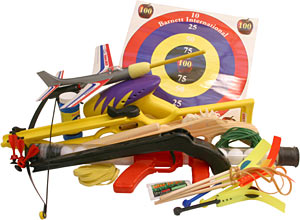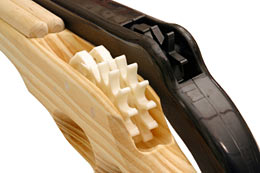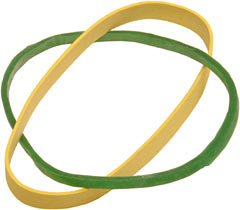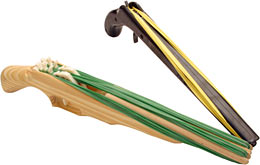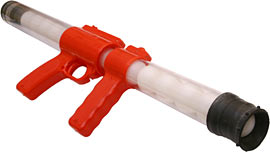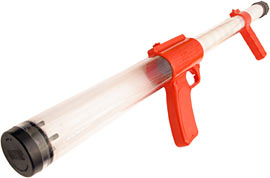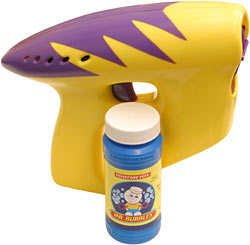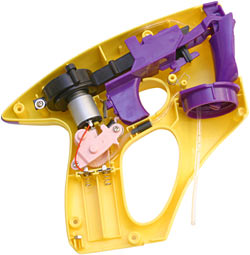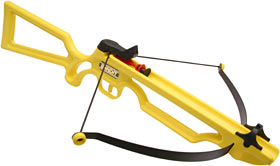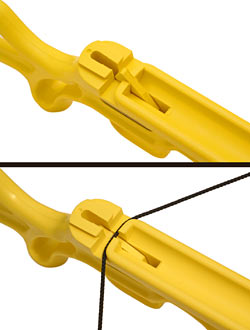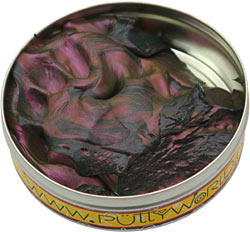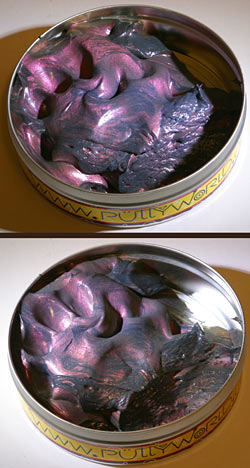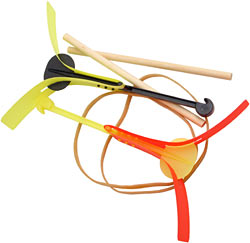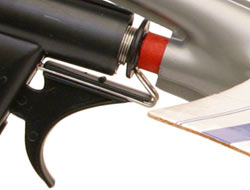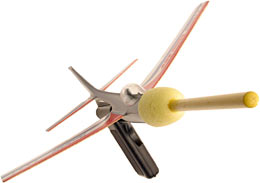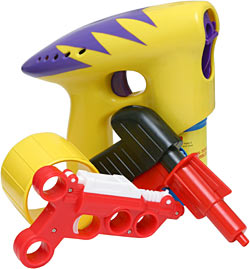
Assorted office toys
(well, mainly office toys)
Review date: 7 August 2002. Last modified 03-Dec-2011.
There are, in this world, presumably, some people who derive deep satisfaction from working in an office.
Paperwork thrills them. Word processing absorbs their entire consciousness. It might not even be going too far to say that spreadsheets give them what, in the vernacular, may sometimes be called "their jollies".
Those people can stop reading right now.
This review is for the rest of the world's working schmucks. The people who are there for the money, not the fun, but could nonetheless do with a little entertainment while they're trapped in cube-land.
Step right up and get your office toys, people.
Specifically, your cool office toys. Troll dolls, squishy balls, suction-cup basketball hoops and bendy figurines need not apply.
What we're talking about here is stuff that, if you give it to an actual child, will cause them to be convinced that you're the coolest relative ever.
Needless to say, the largest sub-category of Cool Toys is Toys That Shoot Stuff. Some toys in this sub-category cost five thousand US dollars and aren't really suitable for office use unless you want to find out how brave the security guards are. But there are plenty of other options.
And there are other cool office toys that are't gun-like.
I know, I know; I found it hard to believe myself. But you'll see.
Almost everything reviewed on this page came in one big care package, from one of the many business ventures of Ron L. Toms.
Ron's an accomplished self-flinger and TV star, and now he's selling toy siege weapons for a living. As you do.
Ron may only be the second-grooviest dangerous-toys person I've swapped e-mail with, though, depending on what weighting I give to size versus complexity. But I digress.
Anyway, Ron can be blamed for a few Web sites. Trebuchet.com, Mangonel.com, and Backyard Artillery, to name just three.
That last one sells toys. Cool toys. The Catapult Watch that I reviewed here, for instance.
And some other stuff.
Like these, for instance.
Twang!
Anyone can shoot a rubber band at someone. From your finger, from a ruler, from your hand bent into the rubber-band-gun shape where your little finger releases the band, which will then probably miss.
For real weight and/or duration of rubber band fire, though, you need a purpose-built weapon.
Here's the ISO Standard Semi-Automatic Repeating Rubber Band Gun, the MAG-45 Snapshot. It costs only $US9.95 from Backyard Artillery, and it accepts from one to six rubber bands. The Snapshot comes with 12 thick yellow rubber bands; 20 more are two US bucks. You don't need to use the special bands, though; practically any rubber band that'll stretch to a bit more than 30cm (one foot) will do. There are places that'll sell you a hundred pounds of 'em.
The star wheel mechanism that allows the Snapshot to work its magic is a simple escapement. You load it by hooking bands over the notched nose of the gun, then stretching them back and over the upward-pointing tooth on the wheel. Then you click the wheel back one notch with your thumb, to bring a fresh tooth into view.
The tension of the rubber bands makes the wheel want to turn to release them, but that can't happen until you pull the trigger. Pulling it lets the wheel turn far enough to release the band hooked over the topmost tooth; releasing the trigger lets the wheel turn a bit further, to bring the next tooth to the vertical position. This means you get two impressive clicks per shot, as well as the thwack (and optional "Ouch!") of the band hitting its target.
If you want a "safety catch" to stop the band on the uppermost tooth from slowly sliding up and off it, you can just click the wheel back one more notch.
The shooting satisfaction factor of a semi-automatic rubber band gun is very, very high. You have to spend a little while loading it, true, but if you find yourself caught short in an inter-cubicle grudge match, you don't have to load the gun fully before you fire it.
The standard yellow bands are rather meatier than the average office paper-bundle-holder, so people shot with the Snapshot at normal office ranges aren't likely to be unaware of that fact.
The Snapshot is not very hard to load. It's pretty unlikely that you'll mis-load it by tucking a later band under an earlier one. It's solidly constructed, from two screwed-together plastic halves. It's priced to move. And its six shot wheel moves 60 degrees with every shot, which combined with the plastic body gives the Snapshot a really loud double click each time you fire a band.
If you've got a Snapshot and your opponent has one of these, though, you're about to taste stinging elastic humiliation.
This baby is one of Surefire Products' rubber band guns. It works in essentially the same way as the Snapshot, except it's made of wood, and it uses Surefire's 12-shot star wheel assembly.
Actually, this one uses two star wheels, and has two triggers. Its total rubber band capacity is thus a cubicle-covering 24 shots.
The Backyard Artillery product description calls this an "18th Century Duelling Pistol"; Surefire Products call it the "Dragoon". Surefire sell it direct for $US32.95 plus shipping with no ammunition included, but Backyard Artillery have it for a mere $US24.95 plus shipping, and throw in 24 ammo-bands. A quarter-pound bag of extra ammo - which contains One Quantity of rubber bands - is another three US bucks.The star wheels compared.
The Dragoon, or Duelling Pistol, or whatever, is about the same length as the Snapshot, so it can use much the same sorts of rubber bands. Its high ammo capacity, though, means it's more likely to jam if you use wide bands. It's also more difficult to fully load, at least if you use its standard bands.
Here's one of the yellow Snapshot bands next to one of the green Surefire ones. The Snapshot ones have a bit more zing, but loading the Duelling Pistol with the slightly weedier Surefire bands is hard enough already. A kid couldn't finish the job, even with bands that've been shot a few times and stretched a bit; with brand new bands, I could hardly finish it myself. OK, I'm a pencil-necked geek. But still.
The flipside of this, of course, is that the Surefire bands pack a punch. Not quite as much punch as the thicker Snapshot bands, but plenty more than you'll get from plain thin office rubber bands.
With twenty-freaking-four shots at your disposal, the Dragoon/Duelling Pistol/Whatever is a serious piece of office ordnance. Workmates will ignore it at their peril. Close-range bombardment on bare skin is not something you should do to people you like. Unless they're into that sort of thing, of course.
Both of these guns can shoot as fast as you can pull the trigger(s) (or apparently, with modifications, faster). The dual triggers on the Surefire Products gun mean that as long as you haven't misloaded it, and thereby caused a trapped band to flop around on the end of the gun and get in the way, you can easily unload all 24 bands in less than five seconds. Or, of course, you can keep up a lazy suppressive fire for a whole minute, without reloading.
The six-band Snapshot, naturally, lacks the sustained-fire or hail-of-rubber capabilities of the Surefire guns. Even the single-wheel Surefires have twice as many shots as the Snapshot. But on the other hand, the Snapshot's heavier bands fly a bit further, and it's easier to load.
The Snapshot also has a better finish than the Surefire guns. The Duelling Pistol, like the other Surefire guns, is made out of plain uncoated wood, with some uneven edges and some questionable mould work on the plastic parts. It works fine, but it doesn't look entirely finished. If you want something that looks nice then you're going to have to sand and paint or varnish the gun yourself.
People sell Snapshots online for as much as $US20; Backyard Artillery's price is a good one. They also stock some other Surefire guns; you can see the range here.
Backyard Artillery also, by the way, sell Surefire Products' flagship model, the preposterous 144-shot Gatling gun. But, at $US395, they're not exactly expecting to shift ten of them a week.
Surefire originally priced the machine gun at $US495, but since the dot-com bust the price has, oddly, dropped.
Want something a bit less ouchy, but just as capable of very definitely shooting someone? Can do.
Burp!
Behold: The ACK-ACK Burp Gun.
The Burp Gun, as anybody who visits its official site will know, has a bit of history behind it. The Burp Gun you can buy today is much the same as the one you could buy more than 40 years ago, and it's still a darn good way to project a storm of slightly accurate plastic balls at an unsuspecting victim.
The Burp Gun is made out of two clear concentric tubes, one of which runs the full length of the gun, is filled with 15 ammo-balls, and is attached to the front red plastic handle. The other tube is half as long, is attached to the rear handle, and is reasonably well sealed around the longer tube, which has an air hole at the back end and a rubber sphincter-y thing at the front. The two tubes aren't keyed together in any way, so you can turn them relative to each other; the handles don't have to point in the same direction.
Extending and compressing the Burp Gun makes it work like a pump. What it pumps is little plastic balls.
At rest, the Burp Gun is about 54cm (21 and a bit inches) long.
Slide the handles apart, though, and it's more like 76cm (30 inches). Opening the gun up sucks air in through the hole in the front, but closing it again pushes the column of balls into the front sphincter, and the frontmost ball makes a fairly airtight seal. Push the handles together hard enough and air pressure pops the front ball out of the sphincter, making a louder popping noise than you'd think would be strictly necessary. If you push the handles with enough gusto, you can fire a few shots per pump.
This means it's easy to empty the Burp Gun in a couple of seconds, though the combination of unpredictable ball release characteristics and aiming inaccuracies caused by pumping means that, in pray-and-spray mode, the thing is about as accurate as a lawn sprinkler. With a spray of 15 balls, though, you're pretty much sure to hit something.
The business end of the Burp Gun can be rolled back on itself for reloading. Getting the balls back into the gun is, therefore, easy. Finding them is the tricky bit.
If you lose your Burp Gun balls in all of the places where parents typically find such things ten years later, don't think you can just go to the local sporting goods place and buy more. Standard table tennis balls are 40mm in diameter; Burp Gun balls are a hair over 31mm.
If you're feeling charitable, you will of course assume that this smaller ball size was forced upon the noble Burp Gun engineers by the physical characteristics of the launch system. Larger balls just didn't work right, despite the engineers' heroic efforts.
If you're not feeling charitable, you might speculate that extra balls may well be to the Burp Gun manufacturers what blade cartridges are to Gillette.
The main Burp Gun site here sells single Burp Guns for $US25, and single Burp Pistols (the same thing but smaller, with a 7 shot capacity) for $US18.50, but these prices include US shipping. Backyard Artillery's prices are $US19.95 and $US14.95, shipping not included; US customers will pay $US24.45 and $US19.45 respectively, including shipping.
Backyard Artillery will sell single Burp Guns to foreign purchasers. The Burp Gun site won't. You can place foreign orders there, but only for guns by the case. The case pricing is pretty good - 12 Burp Guns and 12 10-ball extra ammo packs, or 18 Burp Pistols and another 120 balls, for $US250. But if you don't actually need to outfit squads of Burp Gunners, then Backyard Artillery's clearly a better place for non-USAnians to satisfy their ball-shooting urges.
The Burp Gun has an excellent combination of silliness and functionality. And even if you shoot someone in the face at close range (in, for instance, a cubicle-wall pop-up guerilla attack), you're unlikely to manage to do them any real harm. It makes a lot of noise, it produces a lot of missiles; if it used normal ping-pong balls, it'd be perfect. As it stands, it's still very good.
If you'd prefer something completely non-violent, though, then do I have a gun for you.
Peace, love and bubbles
This is a bubble gun. In theory at least, it can blow a constant stream of bubbles for as long as its two AA batteries hold out. In reality, you'll have to release the trigger now and then to re-create the bubble-producing membrane. But the thing's still quite impressive.
The bubble gun could have been created on a dare - "I bet you can't make a peaceful gun toy."
Any kid who can weave a militaristic fantasy around shooting a bubble gun should get some sort of medal for imagination. I suppose they could pretend the bubbles contain nerve gas or something, but apart from that they're stuck with imagining they're a cute little video game dragon, at best.
The liquid bottle's labelled "Mr Bubbles", which has some rather unfortunate associations for us Australians. But that's about it for bad thoughts engendered by this device.
Backyard Artillery are selling the bubble gun for a mere $US9.95 plus shipping, including the four ounce bubble solution bottle. Extra bottles are $US1.49 plus shipping each; of course, there's nothing stopping you from refilling the bottle with home-made bubble solution.
Compared with the possible other purchases likely to be made by adults who buy one of these things, this gun's pretty darn cheap.
The bubble gun's battery compartment is held closed by a Philips head screw, presumably to stop kids (or persons enjoying a state of pharmaceutical enhancement) from opening it and losing the batteries. The two AAs aren't included.
Unfortunately, the first bubble gun I got for review didn't, well, work.
To use it, you're meant to prime the solution-pump with water before screwing the solution bottle in place (the gun is not completely leak-proof, but it's a lot less spillable than you might think), then hold the trigger down until the solution makes it to the bubble ring at the front.
When I did that, the little motor inside laboured away as the gun primed, and it managed to get fluid to the bubble ring, and the gun blew a feeble breeze that caused the membrane of fluid to bulge outwards a bit, but it could barely manage to blow one tiny bubble before the motor ground to a halt.
It was, clearly, time to have a look inside.
Everything inside the bubble gun runs from one little motor, which drives the pump from one end and the blower from the other. The pump is a peristaltic arrangement, driven through a great deal of gear reduction; it delivers a trickle of bubble fluid to the ring at the front of the gun. There's a drain under the ring to return excess fluid to the bottle.
The blower on the other end of the motor is a simple direct drive unit, and it provides the breeze to eject the bubbles. The whole thing's turned on and off by a simple contact operated by the trigger. The trigger also pulls a spring-loaded gate up over the bubble ring, to create a membrane. The whole arrangement is a good example of the basic toy design credo - keep the thing simple so you can sell it cheap. I wouldn't say it's the pinnacle of this philosophy - here's a better contender - but it's in the running.
The problem with this one is the motor. Everything else works fine, and the trigger-switch makes perfectly good contact, but the motor just doesn't want to turn. It's not a motor type I've seen on the shelves of my local electronics places, so I can't replace it.
Backyard Artillery duly sent me another bubble gun, which works fine, as you can see here. I've got no reason to believe that these things are particularly likely to be dead on arrival; I've seen a few of them before, happily pumping out streams of bubbles.
Assuming your bubble gun works - which seems to be a pretty safe assumption - the advantage of the thing isn't that it can blow bubbles continuously, though the pump-feed system and un-lung-limited air supply does let the gun blow more bubbles in one go than a human could manage with an ordinary small bubble wand.
The gun's advantage, rather, is the fact that it blows bubbles every time you pull the trigger - or almost every time, anyway - and that's all you have to do. You don't have to dip anything in a little bottle, so there's no way to miss, and nothing to (easily) spill. Turn the gun on its side and fluid will slowly leak out, but if you keep it upright, it shouldn't get sticky.
This sort of sober benefit analysis feels a bit weird to write, but it's true. The product, when it works, is sound, and better than the cheaper lung-powered option in the abovementioned ways.
But it's just so... so darn hippy-ish. The fear of a stinging sensation if a bubble gets in your eye is the most terror you can inspire with one of these things.
That's the whole point, of course, but I'm firmly convinced that there must be at least a vague impression of dangerousness for a toy to be truly cool.
Let me show you what I mean.
Dart power!
Sucker dart guns, generally, well, suck. They're powered by weedy little springs, and they have air chambers with leaky pistons, and darts that practically never fly straight, and don't fly very far, and need to be licked before firing if you want them to have a good chance of sticking.
OK, sucker dart guns are generally really cheap; head to the flea market and you can kit out your whole office with the things for a few bucks a desk. But still. In the real world, they just don't work like they work in the cartoons.
The state of the art in sucker dart guns has advanced somewhat, of course. But most of 'em are still lousy.
What the world needs is a really satisfying sucker dart gun. Something with more power. With mildly predictable aim. With better darts, and solid construction. And, preferably, also with a design that says "ph33r my l33t t0y, biznatch."
Can I get an "Aww, yeah"?
I thought I could.
This is Barnett Crossbows' Bandit.
It's a sucker dart crossbow. Baby.
Barnett Crossbows do not, generally, make toys. Their main products are great big scary huntin' bows, and don't you forget it.
But they also make the Bandit. Which is very nice of them.
Backyard Artillery sell the Bandit for a mere $US24.95 plus shipping; they've got six-packs of extra darts for $US5.95 plus shipping, as well as a couple of Barnett's other less-than-lethal products. The Bandit comes with three darts, and a shiny bullseye target printed on heavy paper. You can also, of course, shoot TV screens, windows and other sufficiently smooth surfaces - or anything else, if you don't care if the darts stick.
Technically, crossbows aren't legal here in Australia, but sucker dart guns don't really count as crossbows, even if they look like them. This one was inspected by Customs and breezed on through. Someone's adorable offspring could, of course, load the Bandit with non-sucker projectiles, like for instance pens of appropriate dimensions. I tried it, and concluded that throwing the pens would be much more dangerous. Anything much heavier than the stock darts doesn't seem likely to be launched properly, even if it's aerodynamic enough to fly straight.
Then again, I bow to the superior knowledge of people who had one of these things when they were kids, and naturally therefore figured out special tricks to make it more lethal.
The body of the Bandit is one piece of high-impact plastic; it's sized for kids to use, but it's fine for adults too. Adults can even shoot it from the shoulder, though you'll be a bit bunched up if you do it. There's a reason to do this, besides just fully buying into the Sherwood Forest fantasy; the Bandit has proper rear and front sights.
Out of the plastic pack, the Bandit needs a small amount of assembly. You put the steel "prod" (the bendy bow part) in the appropriate slot in the body of the crossbow, and fasten it in place by tightening down a screw. The instructions say there should be a notch in the prod to make it easy to centre it perfectly, but the prod in the Bandit kit I got didn't have one. It's not hard to get it centred without assistance, though.
The bowstring's pre-attached to the prod, so the Bandit's ready to shoot after this one assembly step. To cock it, you just pull the string back until it latches at the trigger end, then slide a dart in under the rear sight. The dart can't just hop out of its spot, because the rear sight piece is above it, but if you tilt the Bandit downwards the dart will slide out.
The cocking mechanism, such as it is, with the rear sight removed. Both of the sight pieces can easily come off; the front one's meant to in case of a misfire, to prevent darts from being bent or broken.
The darts themselves have a plastic body and a rubber head, with proper fins at the back. The fins stabilise the dart's flight somewhat.
The Bandit is just plain fun to shoot. It feels good.
The first time I pulled the trigger, it was clear that this thing has a lot more power than the average little spring-powered sucker dart gun. The darts smack into window glass hard enough that they'd stand a good chance of breaking it, if they had a hard nose.
This, of course, raises the question of safety. The Bandit instruction sheet says things like "aim carefully at proper target", and exhorts you not to plink at pets or siblings. Since it's a scientifically proven fact that all normal boys with air rifles will, given time, have an air rifle fight, even if it's been firmly explained to them that if they do this then Christmas will be cancelled for the rest of their lives, you can reasonably expect the don't-shoot-people rule to be broken if you hand a Bandit to a kid. Or, indeed, to many adults.
As long as your target's a human wearing glasses, though, it's very unlikely that you'll manage to significantly harm him or her with a Bandit. Annoy, yes. Startle, certainly. Invite terrible retribution, quite possibly. Maim or kill; no.
By way of an experiment, I shot my bare foot with the Bandit. It hurt a little bit, but a lot less than a shot from my Airsoft tank - and even the tank stands little chance of doing permanent eye damage to anybody, though it'd certainly be able to make them very miserable for a while.
The Bandit is, after all, a crossbow that a quite small child could easily cock by hand. Energy in doesn't exceed energy out; there isn't that much juice in each dart.
That said, the management assumes no responsibility for anybody who somehow manages to blow a workmate's knee apart with a Bandit.
The Bandit isn't tremendously accurate. Sucker darts, even high-class ones like these, aren't aerodynamically impressive, and so you won't get tight dart groupings even at normal couch-to-TV shooting ranges. But the darts do, at least, often hit with the sucker forward, which is more than can be said for the usual one-piece moulded-synthetic-rubber darts. Compared with the Burp Gun, the Bandit is a sniper weapon.
Did I mention the fact that the Bandit's really fun to shoot?
Go and buy one. I'll wait.
Office toys do not, of course, have to be of the projectile-projecting type.
In case you've completely and utterly had it with all of the shooting, let's take a brief break. With something squishy.
Boing.
If your superiors aren't totally cool with the idea of a steam engine pokketa-pokketing away on your desk, bouncing putty is a good geek-Zen alternative.
Bouncing putty is cool. Some people, apparently, think it's icky. Sorry, but these people are not cool. It's as simple as that. No correspondence will be entered into.
Bouncing putty is often referred to as "Silly Putty", which is a brand name that belongs to Binney & Smith, the Crayola people. Alert readers will have noticed that the tin in the picture above does not say "Silly Putty". It says "Crazy Aaron's Thinking Putty", and it's from Puttyworld.
Crazy Aaron (who hasn't, to tell the truth, seemed all that crazy in the e-mail he's sent me) presides over a company that sells much the same bouncing putty product as Binney & Smith, except (a) Crazy Aaron's putty comes in quantities more suitable for adult hands, and (b) Crazy Aaron's putty comes in funkier colours than you can get under the Silly Putty brand. Primary colours, metallics, iridescents; you name it.
Aaron also offers a satisfaction guarantee. If you're not "100% delighted" with your Thinking Putty, you'll get a refund of the purchase price and the shipping fee. You'd have to be rather curmudgeonly to actually take Puttyworld up on this guarantee, but it does show willing.
If you have any appreciation at all for "hand candy" fiddle-toys, you need one or another kind of bouncing putty. A surprising number of otherwise well-educated adults, however, don't know the stuff even exists. This is a shame, because bouncing putty's peculiar viscoelastic properties make it a superb office toy.
In short, for people who haven't encountered it before, bouncing putty is not-very-sticky squishy goop that behaves more like a solid the faster you try to make it change shape. Leave it alone and it flows out into a puddle, over a long period. Push on it gently and it's soft. Pull on it hard and it's hard. Drop it and it bounces. Whack it with a hammer and it shatters. It's strangely pleasant to handle, if you ask me. And it's not actually a useless substance; it's surprising what you can do with the stuff.
This particular Thinking Putty is the charmingly named "Oil Slick", one of the new "Illusions" styles. Illusions putties cost $US7.95 per tin plus shipping, versus $US6.95 ex shipping for Puttyworld's multitudinous other putties.
The Illusions putties cost more because they're iridescent. Oil Slick is supposed to colour-shift through purple, pink, gold, yellow and green, depending on how it's lit.
Well, here it is, lit from one side and then the other. Frankly, I haven't managed to see all of the advertised colours. There's purple, and blue-black, and a hint of gold, and it definitely is iridescent. But it's not exactly a riot of colour.
Still, it looks pretty nifty, and there are a ton of other colours to choose from if this one doesn't turn your crank.
And now, what you've all been waiting for - bouncing putty comparison shopping. Once I've finished the next few paragraphs, my life will be complete.
If you only want a little bit of bouncing putty, don't care particularly what colour it is, and have a local toy store that stocks Silly Putty (they probably won't stock any other brand), then it's very probable that you'll do better to buy a plastic egg or three of Silly Putty from the toy store than to buy a tin from Puttyworld.
sds
If you're in the USA, you can buy Silly Putty online, from the Silly Putty site. There, individual Eggs are only $US1.29 plus shipping, or less if you buy ludicrous quantities. You can also get five pound blocks of putty for $US59.99 plus shipping. There aren't nearly as many colours available as you'll find on Crazy Aaron's site, but if that doesn't bother you and you need a lot of putty to kit out your whole office or party or coven of witches or whatever, then the big blocks are a good deal. But not if you're outside the USA; the Silly Putty site only accepts US orders. Puttyworld will ship anywhere.
Puttyworld's tins have the advantage of containing a proper adult-sized amount of putty. Silly Putty eggs only contain 13.3 grams (0.47 ounces) of putty, which is fine for a kid but not nearly enough to make a satisfying adult handful. The Crazy Aaron tins give you "more than eight times" as much putty as an egg. Which, translated, means that the amount you get varies slightly from tin to tin, but will always be a big handful for people with all but the largest of hands.
Puttyworld also sell one pound bags of putty for $US20, or $US24 for the fancier colours. A pound of putty is rather a lot; the Silly Putty five pound slabs are better value per pound, but five pounds is probably more than you want.
If five pounds isn't more than you want, by the way, you can get putty even cheaper by going straight to the manufacturer. That's the option to take, if you want to perform a really impressive experiment.
Get a hundred pounds and you could make a mattress out of the stuff. I'm not sure that I want to think about that in more detail.
If you don't live in the USA and you, like me, are an if-it-ain't-sold-on-a-Web-site-then-I-can-do-without-it lazy antisocial geek, or if you just really dig one or another of the Puttyworld colours, then their products are clearly for you. The stuff's good value, and really cheap compared with most of the toys that geeks buy. And it is, as I believe I may previously have mentioned, cool.
And now, on to a couple of toys far less suitable for indoor use.
Fly, my pretties!
These are Arrowcopters. Backyard Artillery sell them for $US5.95 plus shipping, for a pack of two.
The Arrowcopter is an ingenious little widget that's pleasingly easy to use. You loop the provided rubber band around the provided wooden dowel, then you hook the notched round end part of the Arrowcopter into the band, grasp the textured tab in the middle of the floppy folded wing-thing, and pull back to tension the rubber band, slingshot-style. Aim vertically and release, and the Arrowcopter streaks into the sky, minimally slowed by the folded wing. The packaging claims that Arrowcopters will "soar 300 feet"; I have my doubts about that, but the things certainly do go up a long way. If you want more altitude, you could just use a stronger rubber band. Like one from your rubber band gun, for instance. But I digress, again.
Once ceiling altitude has been reached, the Arrowcopter's wings flop out further than they did before, and it spins as it descends, startlingly slowly. And rather entertainingly, in my opinion. Particularly when you consider the modest price of these things.
The descent is the time when any crosswinds will try to take your Arrowcopter away, of course. But as flying toys go, Arrowcopters seem to be pretty hard to misplace. And you can even play with prevailing winds, by shooting into the wind and letting it bring the Arrowcopter back to you. Or, indeed, by hunting for thermals or other updraughts; Arrowcopters may be the cheapest slope soarers ever.
And if one does fly away... well, there are worse things you could have lost.
This is the "Arrowcopter Flying Light", which comes with a weeny glow stick, so you can fly it at night and, at least in theory, not lose it. It costs $US4.95 plus shipping, but you only get one Arrowcopter in the package.
The glow stick won't last very long, of course; Backyard Artillery have spare ones for 99 US cents, plus shipping.
I like the Arrowcopters. Even if you diligently apply yourself to playing the games suggested on the back of the package (target shooting, air-time competitions, and so on) they aren't likely to provide days and days of solid entertainment for sober adults. But they're cheap, and they're solid, and they work.
If you'd prefer something more aerobatic, though, your wish can be answered.
This is a Triggerjet Thunderbird. It's a pretty unremarkable plastic and cardboard toy stunt plane with adjustable control surfaces, but it's launched from a spring-loaded gun. The gun fires the plane respectably quickly and consistently; it spits the thing into the air much harder than a small kid probably could. But it's easy for even a small child to load.
There's a hole through the Triggerjet, from its jet-engine-ish underbelly exhaust to its foam covered nose, and you poke the wooden rod of the launcher through it. The launcher's spring is compressed as you push the plane into place...
...and then a simple but reliable wire latch holds the thing in the cocked position.
Backyard Artillery sell Triggerjets for $US9.95 plus shipping; they've got a couple of different styles. Thanks to the simple one-handed launch method, anyone with two hands who buys a pair of Triggerjets can launch them in formation.
Freudian interpretations of the Triggerjet's appearance are, on balance, probably best kept until after the kids are out of earshot.
The Triggerjet is fun to fly. Mis-set its control surfaces or aim poorly and it will, of course, cheerfully imitate a lawn dart, get stuck in a tree, or hit an unappreciative mammal and get ripped apart for its trouble. But the consistent launching system makes Triggerjet flights rather more predictable than those of hand-flung toy planes. And the thing's sturdily made, considering its price.
An office toy, the Triggerjet isn't. Well, unless your office is in a blimp hangar, or something. But as a lazy geek's alternative to a Frisbee, it's not half bad. And kids who can't throw can fly it.
Overall
Backyard Artillery offer a pleasing range of goofy stuff at pretty good prices. Shipping fees will put a serious dent in the value calculation for purchasers outside the USA, of course. But if you live somewhere where you just can't otherwise buy a Burp Gun or Bandit crossbow, full stop, then here's a place that'll send you one of each, plus some other stocking stuffers. Backyard Artillery are a good one stop shop for oddball toys.
Similarly, Puttyworld are not the most economically sensible way for people outside the USA to buy bouncing putty. But they've got good bouncing putty, in sensible quantities and a big range of colours, with a money-back satisfaction guarantee. What's not to like?
Overseas shipping isn't that expensive, anyway. I bought putty from Puttyworld before they offered me my current long-redirecting-URL-affiliate-deal, and two $US6.95 tins plus a $US20 one pound bag only cost $US10 to ship to Australia, by air mail. The US ground shipping price for the same order would have been $US4.64.
Clearly, bouncing putty, rubber band guns, Arrowcopters and the other executive stress relief devices mentioned on this page make sound financial sense.
Go and justify them to your CFO today.
Box-O-Toys kindly provided by Backyard Artillery.
Thinking Putty kindly provided by Puttyworld.
More toys
I've checked out a few more toys, now!
Full disclosure
If you follow any of the Backyard Artillery or Puttyworld links in this review and then buy stuff, I'll get a cut of the profit.
This fact has not influenced the content of this review at all.
The booze and prostitutes these nice people sent me, now they influenced the heck out of me.
But the percentage of the sales? Not at all.
